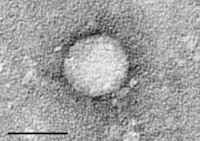
LINC01431 Promotes Histone H4R3 Methylation to Impede HBV Covalently Closed Circular DNA Transcription by Stabilizing PRMT1
Sign Up to like & getrecommendations! Published in 2022 at "Advanced Science"
DOI: 10.1002/advs.202103135
Abstract: Covalently closed circular DNA (cccDNA) is the transcriptional template of hepatitis B virus (HBV), which interacts with both host and viral proteins to form minichromosome in the nucleus and is resistant to antiviral agents. Identification… read more here.
Keywords: circular dna; hbv; transcription; covalently closed ... See more keywords

Surrogate markers for hepatitis B Virus covalently closed circular DNA.
Sign Up to like & getrecommendations! Published in 2022 at "Seminars in liver disease"
DOI: 10.1055/a-1830-2741
Abstract: Chronic infection with the Hepatitis B virus (HBV) is one of the most common causes of liver disease worldwide. Chronic HBV infection is currently incurable because of the persistence of the viral template for the… read more here.
Keywords: markers hepatitis; surrogate markers; hepatitis virus; covalently closed ... See more keywords

Proposed model for the prediction of intrahepatic covalently closed circular DNA level in patients with chronic hepatitis B
Sign Up to like & getrecommendations! Published in 2019 at "Hepatology Research"
DOI: 10.1111/hepr.13280
Abstract: We sought to create a prediction model for intrahepatic covalently closed circular DNA (IH‐cccDNA) level in chronic hepatitis B (CHB) patients and to validate the model's predictive accuracy. read more here.
Keywords: closed circular; circular dna; covalently closed; chronic hepatitis ... See more keywords

Regulatory function of interferon‐inducible 44‐like for hepatitis B virus covalently closed circular DNA in primary human hepatocytes
Sign Up to like & getrecommendations! Published in 2021 at "Hepatology Research"
DOI: 10.1111/hepr.13722
Abstract: Curing hepatitis B virus (HBV) infection requires elimination of covalently closed circular DNA (cccDNA). Interferon (IFN)‐γ has noncytolytic antiviral potential; however, elimination of cccDNA could not be achieved. To enhance the regulatory effect, we comprehensively… read more here.
Keywords: hepatitis virus; circular dna; covalently closed; closed circular ... See more keywords

Research progress on detection methods for hepatitis B virus covalently closed circular DNA
Sign Up to like & getrecommendations! Published in 2023 at "Journal of Viral Hepatitis"
DOI: 10.1111/jvh.13817
Abstract: Hepatitis B virus (HBV) infection remains a serious global public health problem, and HBV covalently closed circular DNA (cccDNA) in the nucleus of infected cells cannot be eliminated by current treatments and is a major… read more here.
Keywords: circular dna; detection; hepatitis virus; covalently closed ... See more keywords

Approaches to quantifying Hepatitis B Virus covalently closed circular (ccc)DNA.
Sign Up to like & getrecommendations! Published in 2021 at "Clinical and molecular hepatology"
DOI: 10.3350/cmh.2021.0283
Abstract: Chronic Hepatitis B is a major cause of liver disease worldwide and is currently incurable. Hepatitis B virus (HBV) covalently closed circular (ccc)DNA is a key form of the virus responsible for its persistence and… read more here.
Keywords: covalently closed; closed circular; dna; hepatitis ... See more keywords

Rapamycin inhibits hepatitis B virus covalently closed circular DNA transcription by enhancing the ubiquitination of HBx
Sign Up to like & getrecommendations! Published in 2022 at "Frontiers in Microbiology"
DOI: 10.3389/fmicb.2022.850087
Abstract: Hepatitis B virus (HBV) infection is still a serious public health problem worldwide. Antiviral therapies such as interferon and nucleos(t)ide analogs efficiently control HBV replication, but they cannot eradicate chronic hepatitis B (CHB) because of… read more here.
Keywords: dna; hbx; transcription; hepatitis virus ... See more keywords

Hepatitis B Virus Covalently Closed Circular DNA Predicts Postoperative Liver Cancer Metastasis Independent of Virological Suppression
Sign Up to like & getrecommendations! Published in 2021 at "Cancers"
DOI: 10.3390/cancers13030538
Abstract: Simple Summary The quantitative assessment of hepatitis B virus (HBV) covalently closed circular DNA (cccDNA) is essential to the development of next generation antiviral therapies against hepatitis B. Here, we developed a peptide nucleic acid… read more here.
Keywords: cccdna; covalently closed; closed circular; dna ... See more keywords

Hepatitis B Virus Capsid: The Core in Productive Entry and Covalently Closed Circular DNA Formation
Sign Up to like & getrecommendations! Published in 2023 at "Viruses"
DOI: 10.3390/v15030642
Abstract: Hepatitis B virus (HBV) relies on the core protein (HBc) to establish productive infection, as defined by the formation of the covalently closed circularized DNA (cccDNA), as well as to carry out almost every step… read more here.
Keywords: cccdna formation; dna; hepatitis virus; covalently closed ... See more keywords

Detection of HBV Covalently Closed Circular DNA
Sign Up to like & getrecommendations! Published in 2017 at "Viruses"
DOI: 10.3390/v9060139
Abstract: Chronic hepatitis B virus (HBV) infection affects approximately 240 million people worldwide and remains a serious public health concern because its complete cure is impossible with current treatments. Covalently closed circular DNA (cccDNA) in the… read more here.
Keywords: detection; covalently closed; circular dna; closed circular ... See more keywords

Cellular Id1 inhibits hepatitis B virus transcription by interacting with the novel covalently closed circular DNA-binding protein E2F4
Sign Up to like & getrecommendations! Published in 2022 at "International Journal of Biological Sciences"
DOI: 10.7150/ijbs.62106
Abstract: Hepatitis B virus (HBV) infection is a major risk factor for hepatocellular carcinoma (HCC), which required developing novel therapies targeting the inhibition of HBV transcription and replication due to current limited treatment options. We explored… read more here.
Keywords: hbv; transcription; hbv transcription; e2f4 ... See more keywords